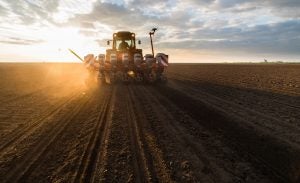Sunday was the first official day of spring, and the warming weather has farmers preparing to plant their fields. To assure corn and soybean planting goes as smoothly as possible — regardless of what Mother Nature throws your way — here is a checklist for the busy season ahead.
“Planning for success begins before the seed enters the ground,” says Justin Irlbeck, LG Seeds agronomist in South Dakota. “Time spent refining your action plan saves valuable time in-season when planters need to roll.”
1. Fine-tune your seed selection, field by field
Review plans made last fall and fine-tune as needed on a field-by-field basis. If shortages of nitrogen force last-minute changes in crop rotation, consult your agronomist to ensure seed choices fit your specific growing conditions.
“Tailoring corn hybrids and soybean varieties to each soil situation provides the biggest bang for the buck,” says Dave Hoy, LG Seeds agronomist in northeast Iowa.
“When finalizing seed selection, also consider the emergence scores listed on the hybrid tech sheets,” says Irlbeck. Hybrid emergence scores can have a major impact on the speed at which a stand is established and its uniformity. “The more we can do to give the best chance of even emergence this spring, the better our chances to maximize yields,” he adds.
2. Check fertilizer availability, and adjust plans as needed
This season’s supply and price challenges warrant a check that fertilizer supplies will meet your needs. Adjust fertility programs accordingly. Nitrogen supplies, in particular, could be problematic. If a producer has a limited supply of nitrogen, odds are he or she will be looking to apply in-season.
Manure is also likely to be more of a hot-ticket item this year given elevated potash and phosphate prices. Producers should plan accordingly.

3. Ready your planter and be patient
Fine-tuning planter settings before entering the field can directly impact yield potential.
“If you have been disappointed by emergence, spend some quality time with your planter adjusting, leveling, and replacing worn parts before you plant the 2022 crop,” Irlbeck says. A planter maintenance checklist with detailed pre-plant guidelines will help.
Hoy emphasizes the importance of checking for proper seeding depth, spacing and seed-to-soil contact as planting gets underway. “Farmers need to stop and get out of the tractor periodically as they go across the field to check planter down-pressure and ensure they are getting proper seed placement,” he says.
After much planning and anticipation, both agronomists stress the importance of waiting to enter fields until conditions are favorable. “Be ready to go, but be patient if fields are too wet or soil temps are too cool,” adds Hoy. “Mudding the crop in creates compaction and can result in yield losses that are far worse than waiting a few days for better weather conditions.”


